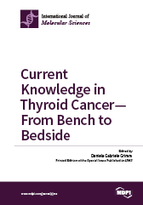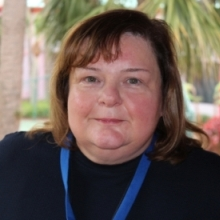Current Knowledge in Thyroid Cancer—From Bench to Bedside
A special issue of International Journal of Molecular Sciences (ISSN 1422-0067). This special issue belongs to the section "Molecular Pathology, Diagnostics, and Therapeutics".
Deadline for manuscript submissions: closed (31 March 2017) | Viewed by 117202
Special Issue Editor
2. Department of Microgravity and Translational Regenerative Medicine, Otto von Guericke University Magdeburg, Pfälzerplatz 2, 39106 Magdeburg, Germany
Interests: breast cancer; thyroid cancer; prostate cancer; cell biology; gravitational biology; space medicine; tissue engineering; pharmacology; apoptosis; SOX transcription factors
Special Issues, Collections and Topics in MDPI journals
Special Issue Information
Dear Colleagues,
In recent years, studies in the field of thyroid cancer have been performed in order to identify and verify thyroid specific biomarkers, as well as cancer-specific changes in gene expression patterns and alterations of the protein content. Furthermore, new drugs, small molecules and antibodies were developed and tested in vitro and in vivo. Trials investigated the ratio between therapeutic and adverse effects. Tyrosine kinase inhibitors (TKI) have become a new therapeutic option of both differentiated thyroid cancer and medullary thyroid cancer. In the last few years, new substances for targeted systemic therapy have been approved after their efficacy was demonstrated in Phase III trials. Most of them show a moderate response. However, adverse effects are common. TKI are used in patients with advanced metastatic thyroid cancer that is radioiodine (RAI)-refractory.
In this Special Issue, original studies on the pathophysiology, diagnosis, and therapy of thyroid cancer, including genetics, proteomics, metabolomics, molecular and cell biology, will be published. It will also cover reports on patients, providing novel mechanistic insights into the underlying pathogenesis or new aspects that may impact clinical therapy, and recent study results in order to review the current status of new therapy options in thyroid cancer.
Dr. Daniela Grimm
Guest Editor
Manuscript Submission Information
Manuscripts should be submitted online at www.mdpi.com by registering and logging in to this website. Once you are registered, click here to go to the submission form. Manuscripts can be submitted until the deadline. All submissions that pass pre-check are peer-reviewed. Accepted papers will be published continuously in the journal (as soon as accepted) and will be listed together on the special issue website. Research articles, review articles as well as short communications are invited. For planned papers, a title and short abstract (about 100 words) can be sent to the Editorial Office for announcement on this website.
Submitted manuscripts should not have been published previously, nor be under consideration for publication elsewhere (except conference proceedings papers). All manuscripts are thoroughly refereed through a single-blind peer-review process. A guide for authors and other relevant information for submission of manuscripts is available on the Instructions for Authors page. International Journal of Molecular Sciences is an international peer-reviewed open access semimonthly journal published by MDPI.
Please visit the Instructions for Authors page before submitting a manuscript. There is an Article Processing Charge (APC) for publication in this open access journal. For details about the APC please see here. Submitted papers should be well formatted and use good English. Authors may use MDPI's English editing service prior to publication or during author revisions.
Keywords
- Thyroid cancer
- Tyrosine kinase inhibitors
- In vitro studies
- Clinical studies
- Molecular biology
- Biomarker
- Pathway analyses
- OMICS investigations







